Practice Free AZ-204 Exam Online Questions
HOTSPOT
You are developing a .NET application that communicates with Azure Storage.
A message must be stored when the application initializes.
You need to implement the message.
How should you complete the code segment? To answer, select the appropriate options in the answer area. NOTE: Each correct selection is worth one point.

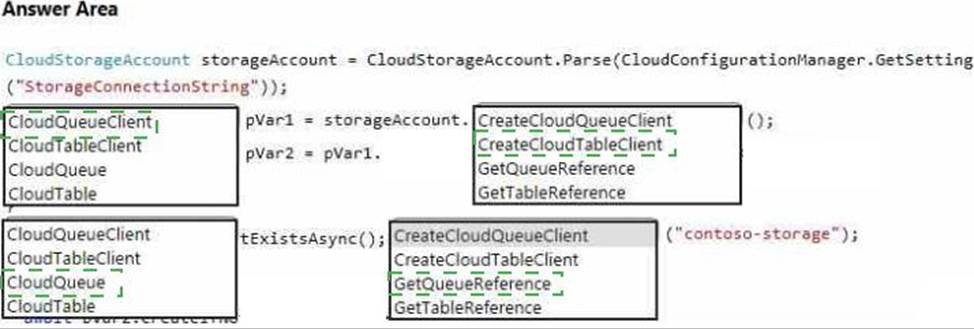
HOTSPOT
You are developing a content management application for technical manuals. The application is deployed as an Azure Static Web app.
Authenticated users can view pages under /manuals but only contributors can access the page /manuals/new html.
You need to configure the routing for the web app.
How should you complete the configuration? To answer, select the appropriate options in the answer area. NOTE: Each correct selection is worth one point.
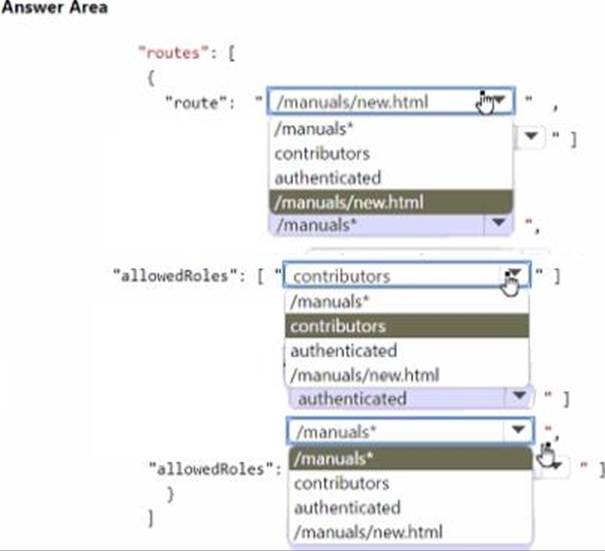
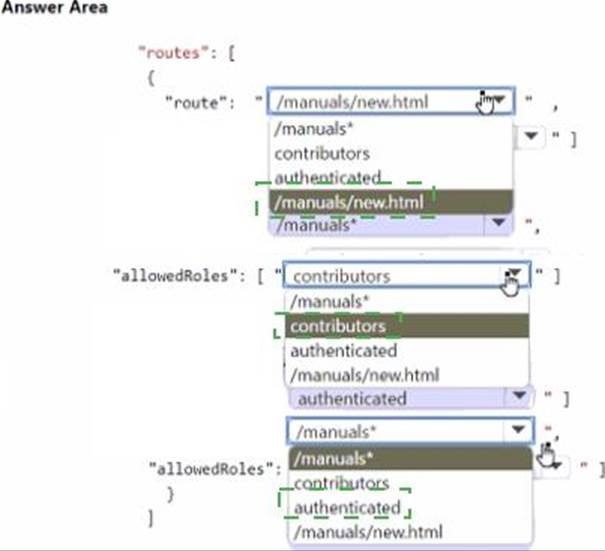
HOTSPOT
You need to retrieve all order line items from Order.json and sort the data alphabetically by the city.
How should you complete the code? To answer, select the appropriate options in the answer area. NOTE: Each correct selection is worth one point.
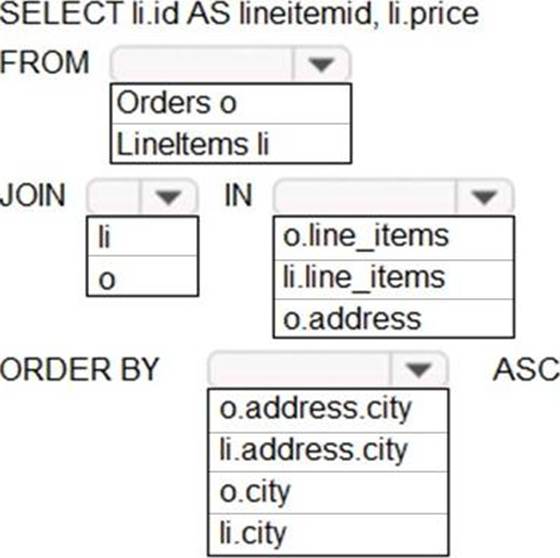
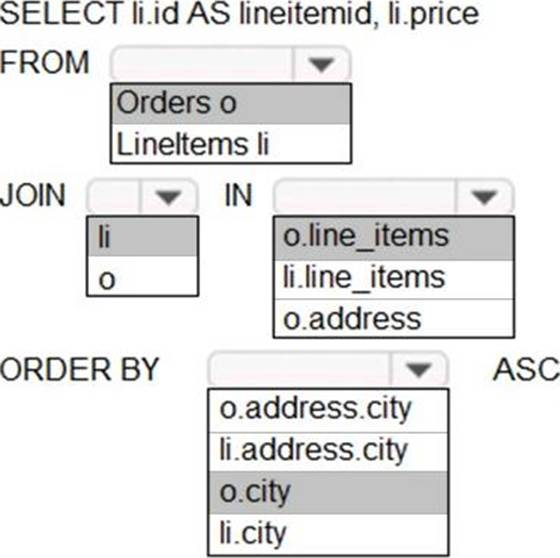
Explanation:
Box 1: orders o
Scenario: Order data is stored as nonrelational JSON and must be queried using SQL.
Box 2:li
Box 3: o.line_items
Box 4: o.city
The city field is in Order, not in the 2s.
HOTSPOT
You need to retrieve all order line items from Order.json and sort the data alphabetically by the city.
How should you complete the code? To answer, select the appropriate options in the answer area. NOTE: Each correct selection is worth one point.


Explanation:
Box 1: orders o
Scenario: Order data is stored as nonrelational JSON and must be queried using SQL.
Box 2:li
Box 3: o.line_items
Box 4: o.city
The city field is in Order, not in the 2s.
HOTSPOT
You are developing a ticket reservation system for an airline.
The storage solution for the application must meet the following requirements:
✑ Ensure at least 99.99% availability and provide low latency.
✑ Accept reservations event when localized network outages or other unforeseen failures occur.
✑ Process reservations in the exact sequence as reservations are submitted to minimize overbooking or selling the same seat to multiple travelers.
✑ Allow simultaneous and out-of-order reservations with a maximum five-second tolerance window.
You provision a resource group named airlineResourceGroup in the Azure South-Central US region.
You need to provision a SQL SPI Cosmos DB account to support the app.
How should you complete the Azure CLI commands? To answer, select the appropriate options in the answer area. NOTE: Each correct selection is worth one point.
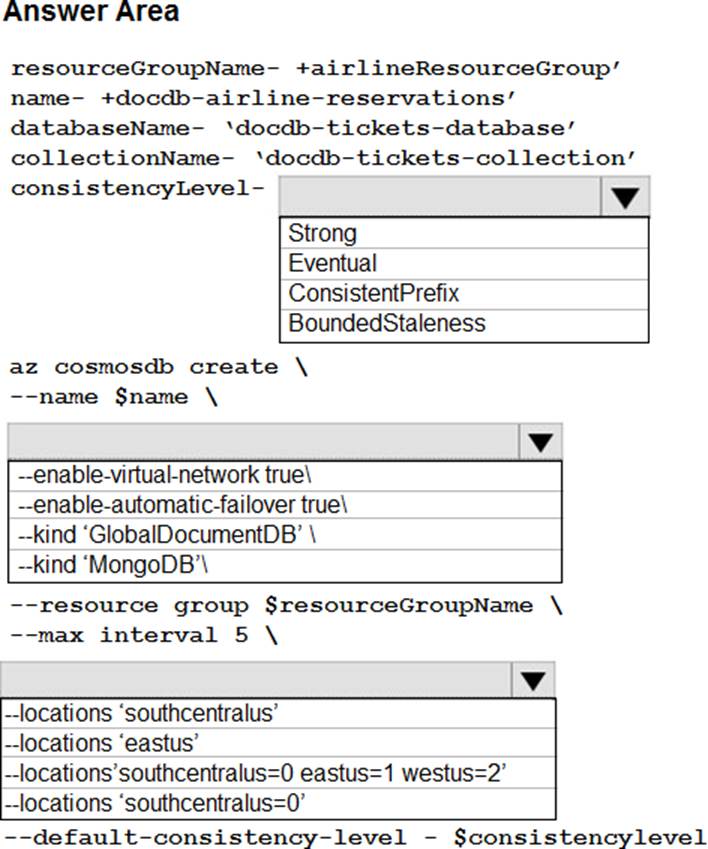
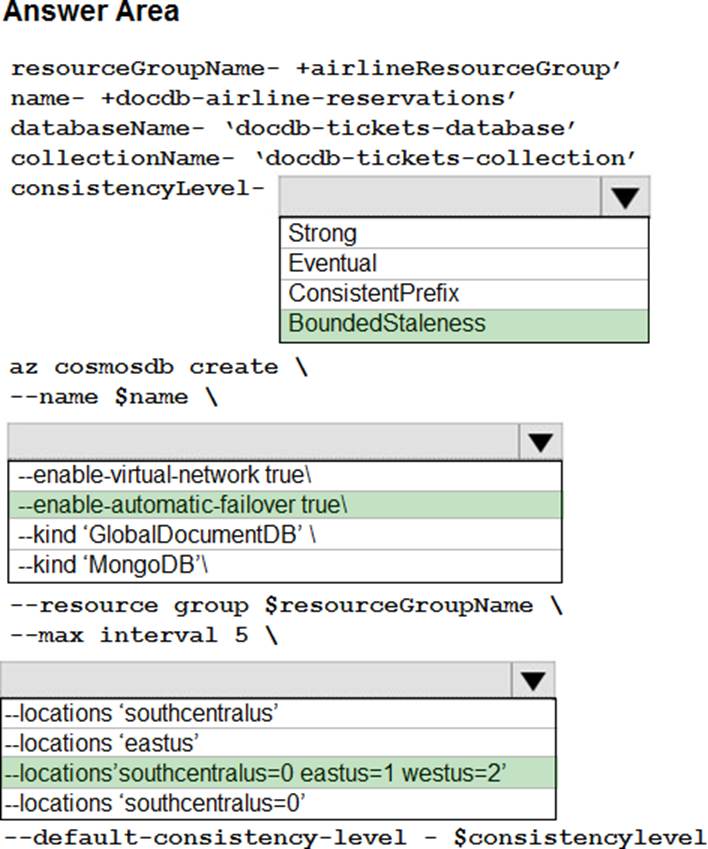
Explanation:
Box 1: BoundedStaleness
Bounded staleness: The reads are guaranteed to honor the consistent-prefix guarantee. The reads might lag behind writes by at most "K" versions (that is, "updates") of an item or by "T" time interval. In other words, when you choose bounded staleness, the "staleness" can be configured in two ways:
The number of versions (K) of the item
The time interval (T) by which the reads might lag behind the writes
Incorrect Answers:
Strong
Strong consistency offers a linearizability guarantee. Linearizability refers to serving requests concurrently. The reads are guaranteed to return the most recent committed version of an item. A client never sees an uncommitted or partial write. Users are always guaranteed to read the latest committed write.
Box 2: –enable-automatic-failover true
For multi-region Cosmos accounts that are configured with a single-write region, enable automatic-failover by using Azure CLI or Azure portal. After you enable automatic failover, whenever there is a regional disaster, Cosmos DB will automatically failover your account.
Box 3: –locations’southcentralus=0 eastus=1 westus=2
Need multi-region.
Reference:
https://docs.microsoft.com/en-us/azure/cosmos-db/consistency-levels
https://github.com/MicrosoftDocs/azure-docs/blob/master/articles/cosmos-db/manage-with-cli.md
A company is developing a solution that allows smart refrigerators to send temperature information to a central location. You have an existing Service Bus.
The solution must receive and store messages until they can be processed. You create an Azure Service Bus instance by providing a name, pricing tier, subscription, resource group, and location.
You need to complete the configuration.
Which Azure CLI or PowerShell command should you run?
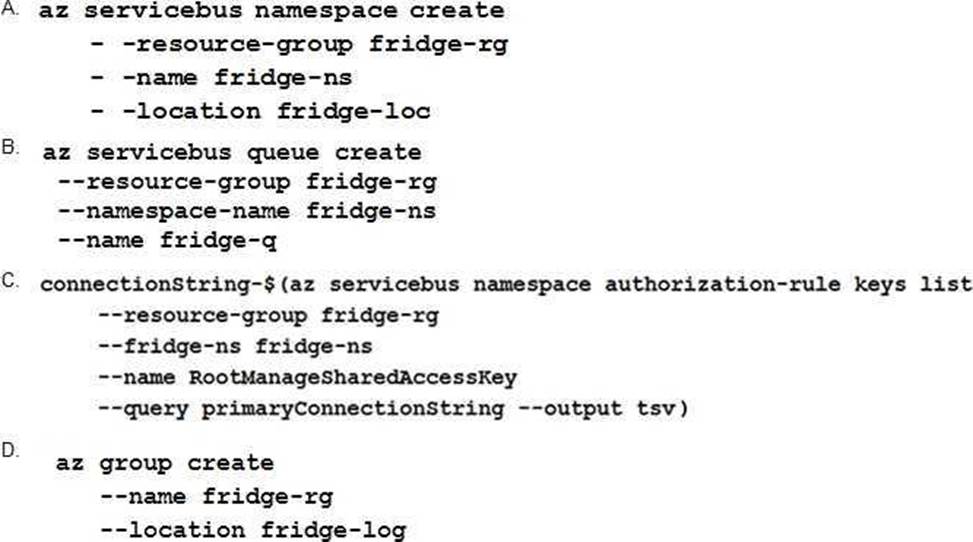
- A . Option A
- B . Option B
- C . Option C
- D . Option D
B
Explanation:
A service bus instance has already been created (Step 2 below). Next is step 3, Create a Service Bus queue.
Note:
Steps:
Step 1: # Create a resource group
resourceGroupName="myResourceGroup"
az group create –name $resourceGroupName –location eastus
Step 2: # Create a Service Bus messaging namespace with a unique name namespaceName=myNameSpace$RANDOM
az servicebus namespace create –resource-group $resourceGroupName –name $namespaceName — location eastus
Step 3: # Create a Service Bus queue
az servicebus queue create –resource-group $resourceGroupName –namespace-name $namespaceName –name BasicQueue
Step 4: # Get the connection string for the namespace
connectionString=$(az servicebus namespace authorization-rule keys list –resource-group
$resourceGroupName –namespace-name $namespaceName –name RootManageSharedAccessKey – -query primaryConnectionString –output tsv)
Reference: https://docs.microsoft.com/en-us/azure/service-bus-messaging/service-bus-quickstart-cli
DRAG DROP
You develop and deploy an Azure Logic App that calls an Azure Function app. The Azure Function App includes an OpenAPI (Swagger) definition and uses an Azure Blob storage account. All resources are secured by using Azure Active Directory (Azure AD).
The Logic App must use Azure Monitor logs to record and store information about runtime data and events. The logs must be stored in the Azure Blob storage account.
You need to set up Azure Monitor logs and collect diagnostics data for the Azure Logic App.
Which three actions should you perform in sequence? To answer, move the appropriate actions from the list of actions to the answer area and arrange them in the correct order.
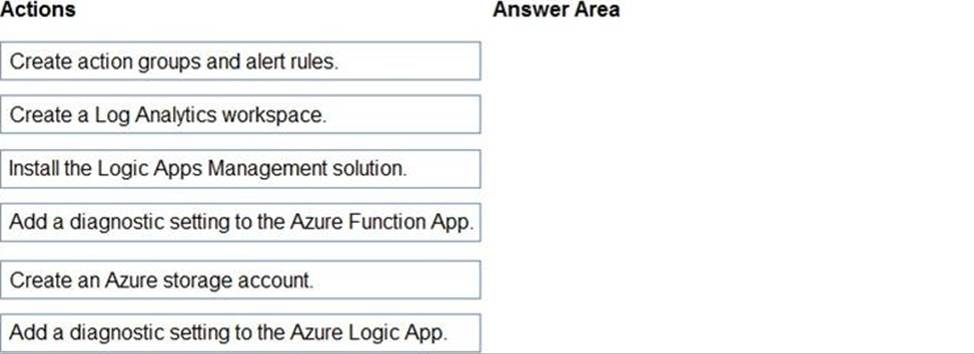
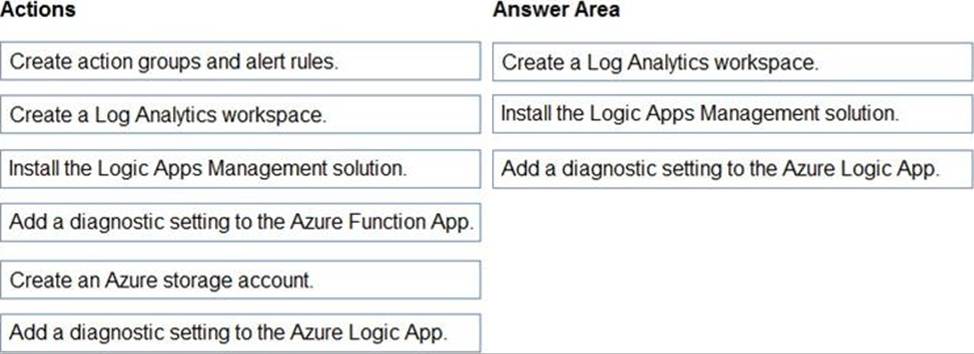
Explanation:
Step 1: Create a Log Analytics workspace
Before you start, you need a Log Analytics workspace.
Step 2: Install the Logic Apps Management solution
To set up logging for your logic app, you can enable Log Analytics when you create your logic app, or you can install the Logic Apps Management solution in your Log Analytics workspace for existing logic apps.
Step 3: Add a diagnostic setting to the Azure Logic App
Set up Azure Monitor logs
In the Azure portal, find and select your logic app.
On your logic app menu, under Monitoring, select Diagnostic settings > Add diagnostic setting.
Reference: https://docs.microsoft.com/en-us/azure/logic-apps/monitor-logic-apps-log-analytics
DRAG DROP
You manage an Azure Cosmos DB for a NoSQL API account named account1. You configure account1 with the default consistency level.
An application named app1 must access containers in account1 to perform read and write operations. The connections from app1 to account1 must be established by using the direct mode.
You plan to configure app1 to override the default consistency level by using the Azure Cosmos DB SDK client.
You need to set the maximum consistency level for app1 to use for read and write operations.
Which consistency level should you set? To answer, move the appropriate maximum consistency levels to the correct operation types. You may use each maximum consistency level once, more than once, or not at all. You may need to move the split bar between panes or scroll to view content.


HOTSPOT
You are implementing a software as a service (SaaS) ASP.NET Core web service that will run as an Azure Web App. The web service will use an on-premises SQL Server database for storage. The web service also includes a WebJob that processes data updates.
Four customers will use the web service.
✑ Each instance of the WebJob processes data for a single customer and must run as a singleton instance.
✑ Each deployment must be tested by using deployment slots prior to serving production data.
✑ Azure costs must be minimized.
✑ Azure resources must be located in an isolated network.
You need to configure the App Service plan for the Web App.
How should you configure the App Service plan? To answer, select the appropriate settings in the answer area. NOTE: Each correct selection is worth one point.
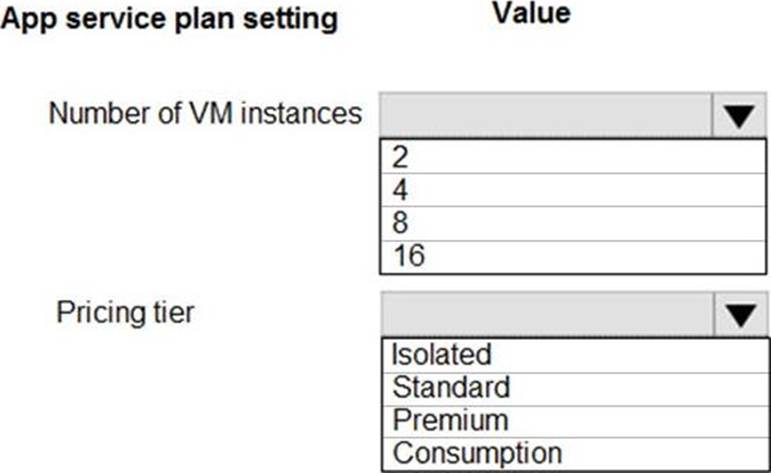
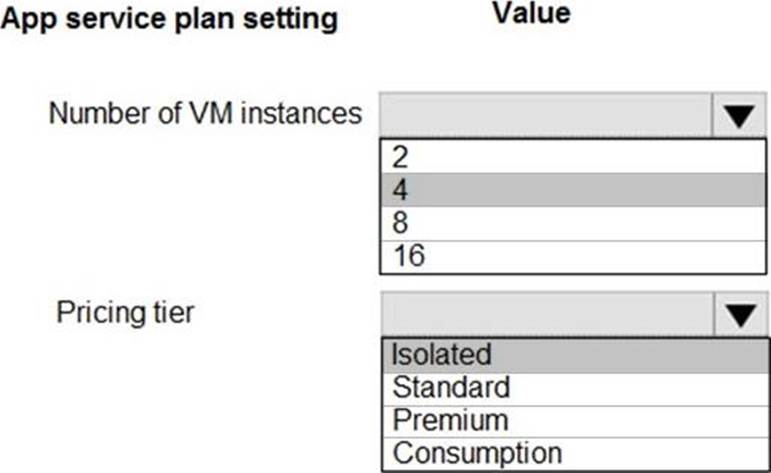
Explanation:
Number of VM instances: 4
You are not charged extra for deployment slots.
Pricing tier: Isolated
The App Service Environment (ASE) is a powerful feature offering of the Azure App Service that gives network isolation and improved scale capabilities. It is essentially a deployment of the Azure App Service into a subnet of a customer’s Azure Virtual Network (VNet).
Reference: https://azure.microsoft.com/sv-se/blog/announcing-app-service-isolated-more-power-scale-and-ease-of-use/
DRAG DROP
You are developing an application to securely transfer data between on-premises file systems and Azure Blob storage. The application stores keys, secrets, and certificates in Azure Key Vault. The application uses the Azure Key Vault APIs.
The application must allow recovery of an accidental deletion of the key vault or key vault objects.
Key vault objects must be retained for 90 days after deletion.
You need to protect the key vault and key vault objects.
Which Azure Key Vault feature should you use? To answer, drag the appropriate features to the correct actions. Each feature may be used once, more than once, or not at all. You may need to drag the split bar between panes or scroll to view content. NOTE: Each correct selection is worth one point.


Explanation:
Box 1: Soft delete
When soft-delete is enabled, resources marked as deleted resources are retained for a specified period (90 days by default). The service further provides a mechanism for recovering the deleted object, essentially undoing the deletion.
Box 2: Purge protection
Purge protection is an optional Key Vault behavior and is not enabled by default. Purge protection can only be enabled once soft-delete is enabled.
When purge protection is on, a vault or an object in the deleted state cannot be purged until the retention period has passed. Soft-deleted vaults and objects can still be recovered, ensuring that the retention policy will be followed.
Reference: https://docs.microsoft.com/en-us/azure/key-vault/general/soft-delete-overview
